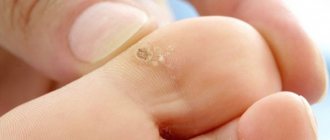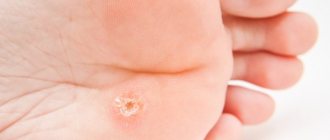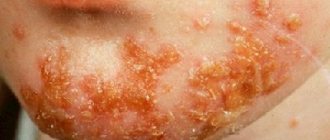Photo: Spine on the foot (plantar wart)
The sensation of a foreign body in the skin of the foot, pain and burning may indicate that a person has a thorn. A thorn on the leg is nothing more than a wart. Most often, plantar warts appear in those areas of the leg that experience the most stress when walking. Much less often, this seal appears on the palms or fingers.
Externally, the spine on the foot is almost no different from a plantar wart. The seal may be slightly convex, which causes additional inconvenience to patients in the form of pain, discomfort, and problems when choosing shoes.
However, you cannot get rid of a spine like a wart. Conventional cosmetic procedures in the form of filing away dead skin or cutting it off will not have the desired effect. Getting rid of a plantar wart can be very difficult. Often, to solve this unpleasant problem, patients have to see a doctor.
Despite the specificity of the disease, the spine can also be removed by using traditional methods of therapy. The main thing is to choose the most effective and safe treatment option for health and first consult a doctor.
- What is a thorn on the leg: symptoms, causes and signs How is it formed?
- Causes
- Symptoms and signs of the disease
- Electrocoagulation
What is a thorn on the leg: symptoms, causes and signs
The spike is viral in nature. Education received this name due to the sensations that a person experiences when walking. Usually, people feel a stabbing sensation, similar to a thorn prick.
Photo: Like a plantar wart
How is it formed?
The formation of a plantar wart begins with the appearance of a white nodule on the sole of the foot, slightly protruding above the surface of the skin. Later, as it develops, the formation begins to resemble a corn or keratinized callus. The size of the spine usually reaches 1-1.5 cm.
The base of the spine is not the usual accumulations of horn cells, but thread-like growths. These growths can penetrate far into the tissues. Thus, they damage nerve fibers and cause pain in a person.
A wart may appear as a single formation or as a large group of warts. When numerous spines appear, one, the largest, “mother” spine can be identified. All other “daughter” warts are much smaller in size and are located around. Numerous plantar warts cause a person a lot of discomfort and are very difficult to treat.
Photo: Spine on toe
Causes
There is only one cause of warts on the foot - the human papillomavirus.
Important : There is an opinion that the cause of the spine may be parasites in the intestines. In fact, this is a medically unfounded misconception.
The virus infection scheme is quite simple. It is enough for a person to scratch the skin. After this, the virus enters the human body and penetrates the genes of skin cells. Then the cells become deformed and begin to resemble a tumor, turning into a wart.
Photo: Spine on a child’s leg
Most often, infection occurs in childhood. Children usually become infected with the virus in kindergartens, schools, on beaches or in public showers. Only those children whose immunity is weakened get sick.
Appearing in childhood, the spine disappears during adulthood. Since the immunity of an adult is stronger, warts appear very rarely.
The risks of transmitting the virus increase when the carrier’s feet are injured. Scratches, calluses, cuts and abrasions are dangerous for people who are not infected with the virus. The papilloma virus present in the body is provoked by several factors:
- sweating of the soles;
- uncomfortable, narrow shoes;
- rubber, non-breathable shoes;
- stress.
Symptoms and signs of the disease
Spine is an extremely unpleasant disease. The sensations caused by a plantar wart will significantly impair a person’s quality of life. This manifestation of the papilloma virus is one of the most difficult. The main symptom of a spine is pain. It can accompany a person throughout the entire time until the wart is removed. The pain can be acute, and is especially common when walking or running.
The spine can also hurt due to its tearing. Since there is a cushion of tissue around the wart, its rupture very often leads to severe, sharp pain and even bleeding. It is not safe to damage a wart. If this does happen, you need to treat the wound with peroxide and seal it with a breathable adhesive plaster. Until the wound has completely healed, you should take care to keep your shoes and socks clean.
Another characteristic symptom of a spine is discomfort when walking. The sensation is similar to pressure in the tissues. Patients describe it as feeling like a pebble in a shoe. This is the first symptom of a spine. But the pain comes later, along with the development of the disease and the growth of the plantar wart.
Differences between a spine and a callus
It is very easy to distinguish a spine from a callus. This can be done after taking a hot bath or shower. Steamed skin at the location of the formation becomes “shaggy”. In the middle part of the wart there are one or more black dots. It is from these blackheads that a filamentous process extends into the skin. Unlike a callus, a wart constantly grows.
Photo: Spine on the foot
A callus is more uniform than a wart. The spine is heterogeneous, it resembles cauliflower. There is a depression in the center, and the entire surface structure is covered with small depressions.
Important : A thorn, like any wart, is a benign formation on the human body. The risks of its degeneration are quite high. Tissue damage, stress and weakened immunity can trigger the process of malignancy of the spinal tissue. Therefore, patients need to consult a doctor in a timely manner to combat the wart and its effective removal.
So the differences are as follows:
- The callus has an even structure;
- The callus does not cause pain;
- It can be easily removed using a file and softening procedures;
- The skin of the callus is very thick and convex, on the wart it is uneven, with indentations and villi.
How to remove a splint on a foot? Therapy methods
There are several options for how to remove a spine. First of all, you should consult a doctor and get medical help. Doctors offer several instrumental methods for removing the spine.
Electrocoagulation
This method is very simple and not time-consuming. Typically, patients only need one procedure, during which the doctor can remove several small warts at once. Typically, one session of electrocoagulation takes only 1-1.5 minutes. The time required depends on the size of the warts and their total number. Local anesthesia is used to remove plantar warts.
Before the procedure begins, the doctor treats the skin with antiseptics. After this, an electrocoagulator loop is placed around the spine, due to which the device thermally treats the tissue and leads to the death of the wart. The temperature at which tissue is cauterized is 800 °C. This temperature also cauterizes blood vessels, which helps protect a person from bleeding. After the session, a crust forms on the skin, which falls off when the tissue is completely healed.
Photo: How to remove a splint on a foot
Laser removal of plantar warts
Before the procedure begins, patients must be examined. This allows you to understand how deep the wart is in the skin. In the absence of such an examination, removal may be ineffective. Doctors determine the depth of penetration of the antennae of the spine into the tissue and begin the procedure. Before starting the procedure, the doctor injects novocaine or lidocaine under the wart. After the patient feels that the painkiller has begun to take effect, the doctor puts on glasses and begins the session.
While working with a laser, the doctor removes pathological tissue layer by layer and at the same time cauterizes those vessels that feed the spine. Laser treatment is carried out until the root system of the wart is completely destroyed. After removing the spine with a laser, the patient is left with a small burn. This burn requires constant treatment with antiseptics. The wound itself must be covered with a dry gauze cloth and bandage. The duration of the removal session depends on the number of spines and their size.
Photo: Remove plantar wart with laser, nitrogen
Cryotherapy
This procedure involves removing the spine with liquid nitrogen. When removing spines using this method, antispasmodics are almost never used, the procedure is painless. In some cases (if the spine is large or the skin is thin), painkillers are still used. The procedure is carried out in two different ways - with a catheter or a cotton swab. The last option is used much more often.
The doctor wipes the skin with antiseptics, dips a cotton swab in liquid nitrogen and touches the spine with it. The effect on one wart should last about 5-30 seconds. The exposure time depends on the size of the wart. Longer exposure to nitrogen is required if the patient has a large and deep spine. In this case, nitrogen must penetrate all layers of the skin, right down to the root of the wart, and therefore, exposure to nitrogen can last 25-35 seconds. After the freezing process, the skin acquires a white-pink tint, which indicates the death of skin cells.
In almost 100% of cases, the day after the procedure, patients develop a medium-sized bubble. This skin reaction to low temperatures is quite normal and indicates the effectiveness of the session. Clear or reddish liquid may accumulate inside the bubble. You should not be afraid of this, since this process indicates that certain layers of the skin were affected during cryotherapy. The tip of the bladder is usually the spine itself.
Spine on the leg: surgical treatment
If no methods of removing the spine have helped, patients are advised to see a doctor to get rid of the disease and have the formation surgically removed. There are many advantages of the method:
- High probability of complete removal.
- Effective when removing especially deep spines.
- Minimal likelihood of relapse.
Local anesthesia is also used during the procedure. During the session, the doctor removes all pathological tissue and stitches the wound. However, the procedure also has disadvantages:
- After the session, scars remain.
- The healing time is longer.
- deep incisions may still hurt several days after surgery.
The choice of method by which the spine will be removed depends on the effect of past control methods. The doctor also relies on diagnostic results and general medical history.
Traditional methods
Of all the folk remedies for the treatment of plantar warts, the most popular is celandine. To get rid of the tumor, fresh plant juice or pharmacy tincture should be applied to the wart every day in the morning and evening. To avoid getting the medicine on healthy areas of the skin, they need to be lubricated with Vaseline or a greasy cream. Treatment of the spine in this way takes about 1 month. To speed up the process of achieving a therapeutic effect, before applying celandine to a wart, its top can be cut off with scissors (before removing the top layer of the growth, and immediately after that, the skin should be treated with alcohol).
Celandine. To eliminate thorns on the feet, you can use a product based on vinegar essence. To do this, beat 50 g of vinegar essence with 1 chicken egg (preferably homemade). After this, the product is placed in the refrigerator. A day later, add 20 g of pork fat to the medicine. Mix until smooth. The prepared mixture should be applied to the wart every evening and left for at least an hour, then washed off. The course of treatment is until the tumor completely disappears. To cure a wart in the shortest possible time, you can use a remedy that has been proven over the years – garlic. It is popularly known for its ability to eliminate any viruses. Before starting treatment, the spine should be thoroughly steamed, and then its top should be cut off using nail scissors (the procedure should be performed under sterile conditions). If a small amount of blood comes out, there is no need to worry. After this, cut a clove of garlic in half and apply it to the wound. For greater convenience, it can be secured with a plaster or bandage. The procedure should last about 8 hours, so it is best done at night. The course of treatment is usually 2 weeks, although in advanced cases it may take longer. If desired, garlic can be replaced with grated horseradish root. You can also make medicinal compresses from grated potatoes, but in this case it will take much longer to completely eliminate the wart. It is worth saying that treatment at home can be quite dangerous, so before doing this you should consult a doctor.
How to deal with spine: medications
Medications help remove the spines on the soles of the feet quite well. Today in the pharmacy you can find a variety of medications that have non-cratizing properties, which allows you to quickly and effectively get rid of the problem.
If you suffer from the manifestations of spines and do not know how to remove them, then you should pay attention to reviews of such products:
- Verrucacid is a cauterizing solution and contains two main active substances - metacresol and phenol. These components have toxic properties, which makes it possible to irreversibly destroy the cells of the spine. It should be borne in mind that the medicine can affect the human nervous system. Thus, the drug should be used only in accordance with the instructions.
- CryoPharma is a popular medicinal treatment for thorns, which is affordable and has good effectiveness. It contains refrigerants that allow the substance to be used to treat people of virtually all age categories.
- Lapis - is sold in the form of a special convenient medical pencil, which can get rid of the spine in the shortest possible time. The peculiarity of the product is that it contains silver nitrate. It is he who has a bactericidal effect on the affected tissues.
- SuperClandestine is a budget product with aggressive and burning properties. Sold in pharmacies in the form of a concentrated solution. When removing a spine, you need to be careful and not accidentally apply the product to healthy tissue. If the liquid does get on the skin, it should be thoroughly washed with water and treated with citric or acetic acid (5%).
- Vishnevsky ointment is a universal remedy with anti-inflammatory and disinfectant properties. However, it should be remembered that when treating spines it is strictly forbidden to combine this medicine with other drugs.
- Salipod is a special patch that is treated with salicylic acid. It softens the spines and helps to remove them smoothly. This patch cannot be used if a child or a pregnant woman has warts.
A thorn on the sole of the foot is a tissue disease that can bring significant pain and discomfort to a person in the future. Self-treatment with medications without first consulting a doctor is not recommended.
What does a spitz look like on the heel (photo)
You can look at the photo to see what a spike on the heel is, and we, in turn, will tell you in more detail both about it itself and about how this disease differs from others with similar symptoms. So how can you tell whether you have a thorn (spur), a knob or a callus on your heel?
By itself, a wart on the foot is very similar to a dry callus; it is also yellowish in color. But if you look closely, you can see black dots on it (a consequence of blockage of blood vessels caused by the disease).
Here you will find information on how to treat a callus on the heel, and also how to choose creams and ointments for cracked heels
In addition, a callus is essentially dead skin, but a heel wart is a living formation; if, for example, it is injured, it will bleed. Ignorant people sometimes confuse a wart on the heel with a spur. Here is their difference: a spine is an external formation that grows inward, it is visible on the heel, and a spur is a growth on the bone that may not show itself in any way externally, except for redness caused by inflammation. You can feel the spur tubercle only when the disease is in an advanced stage.








